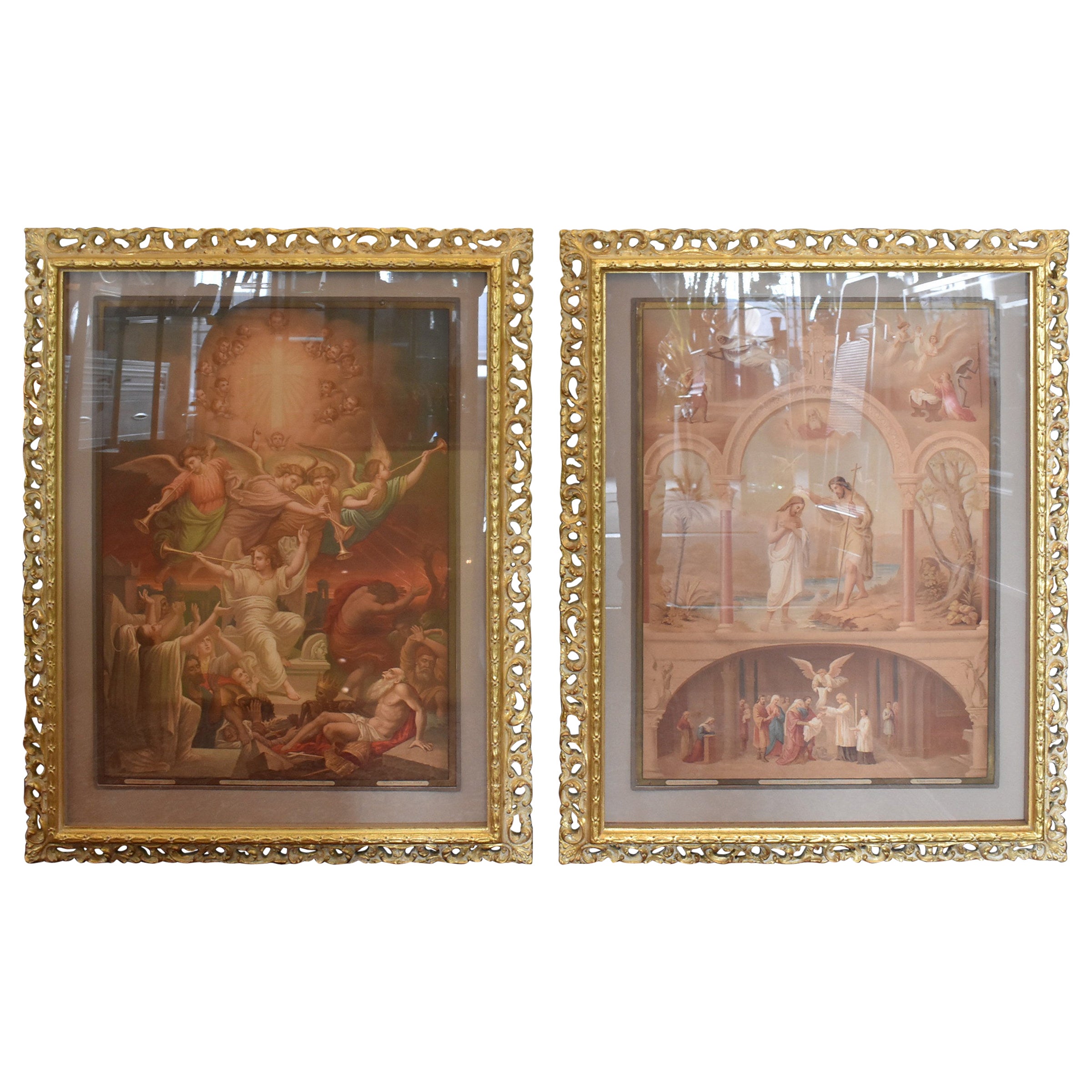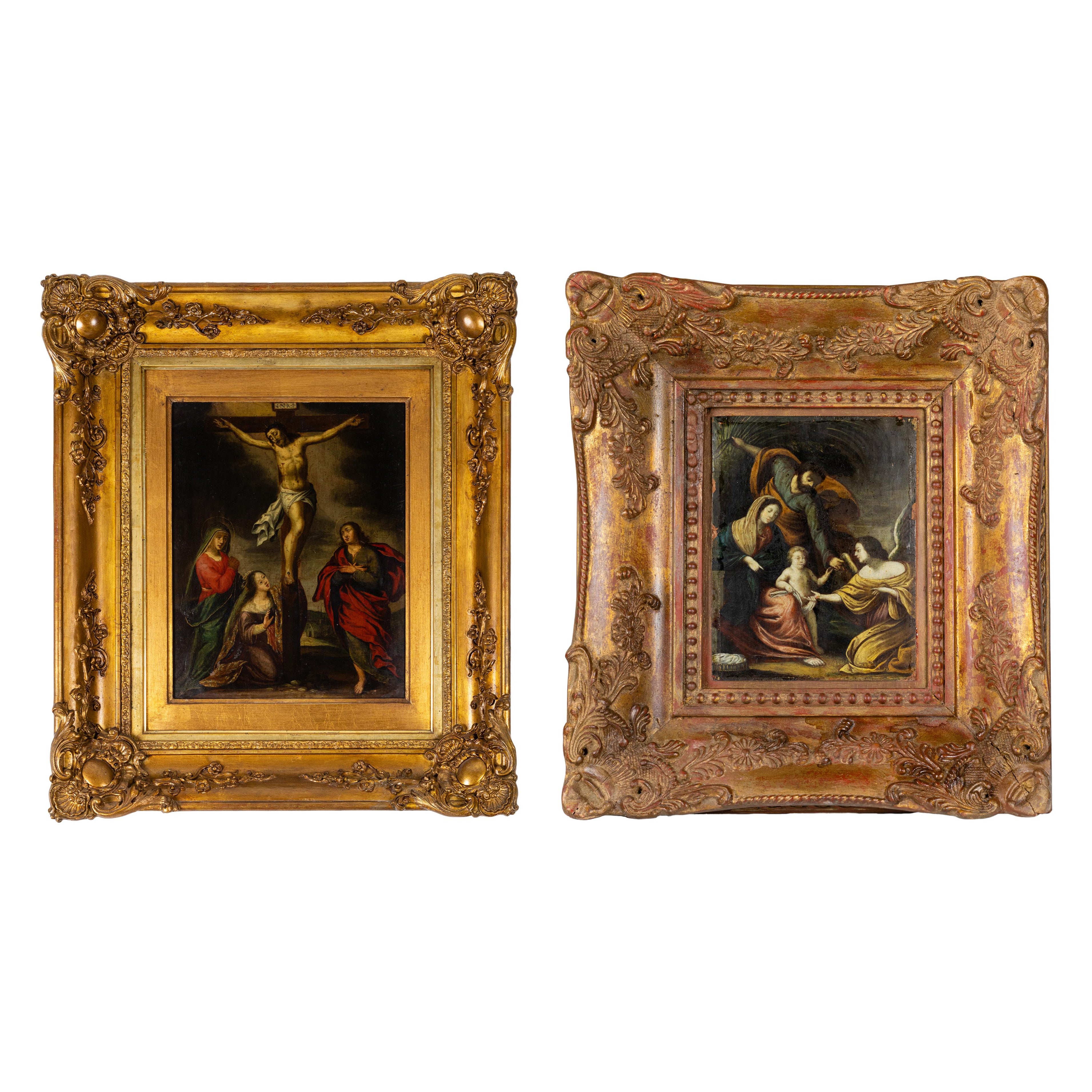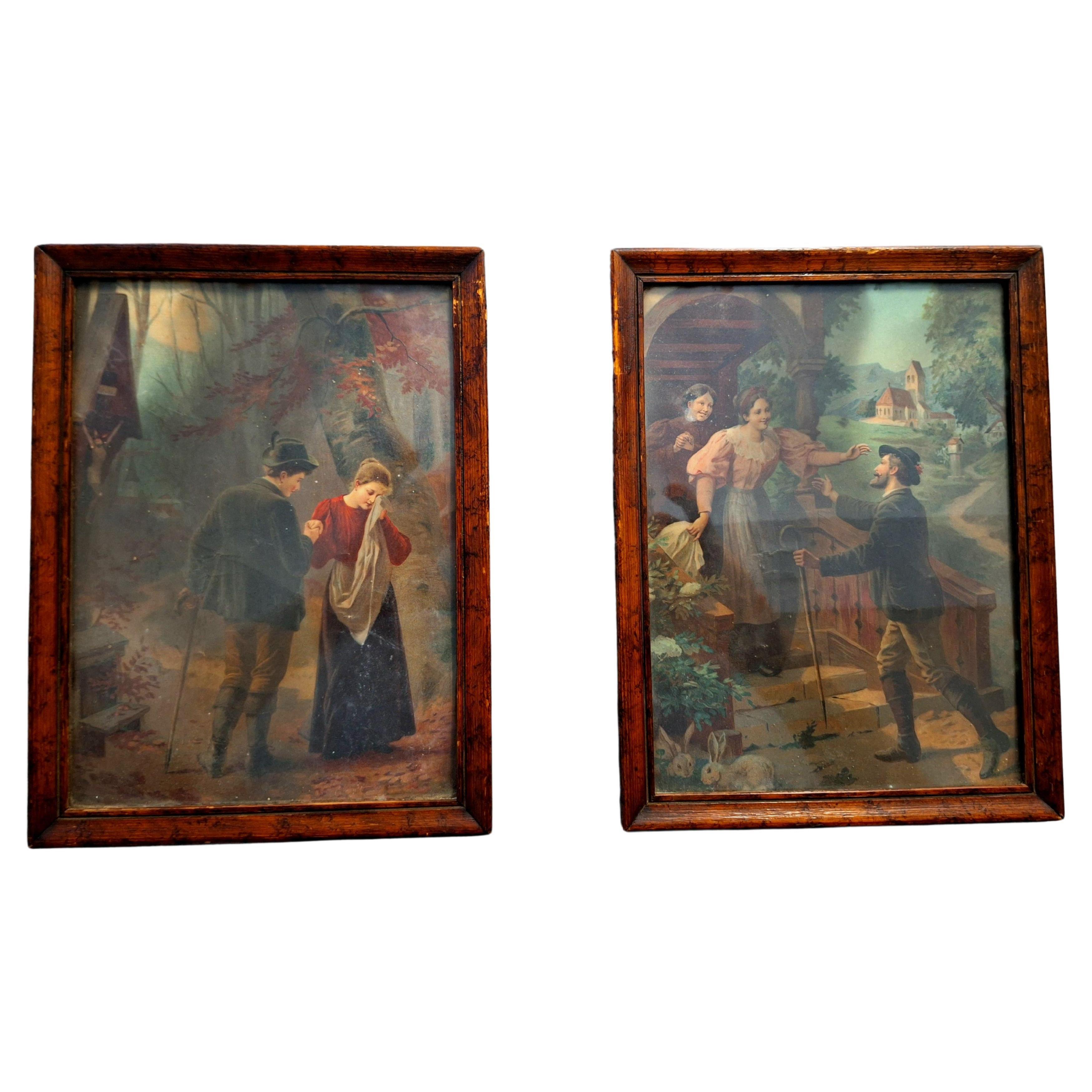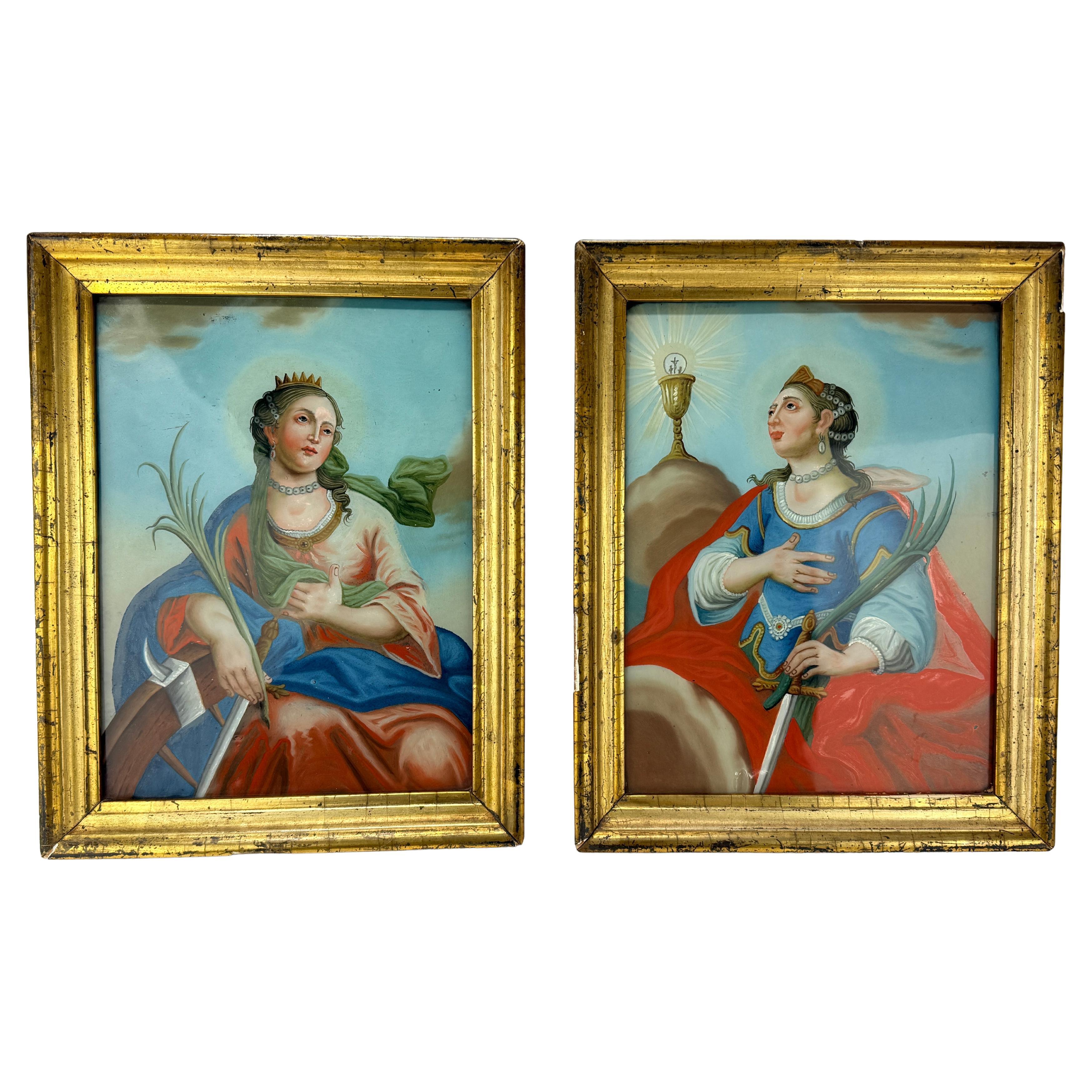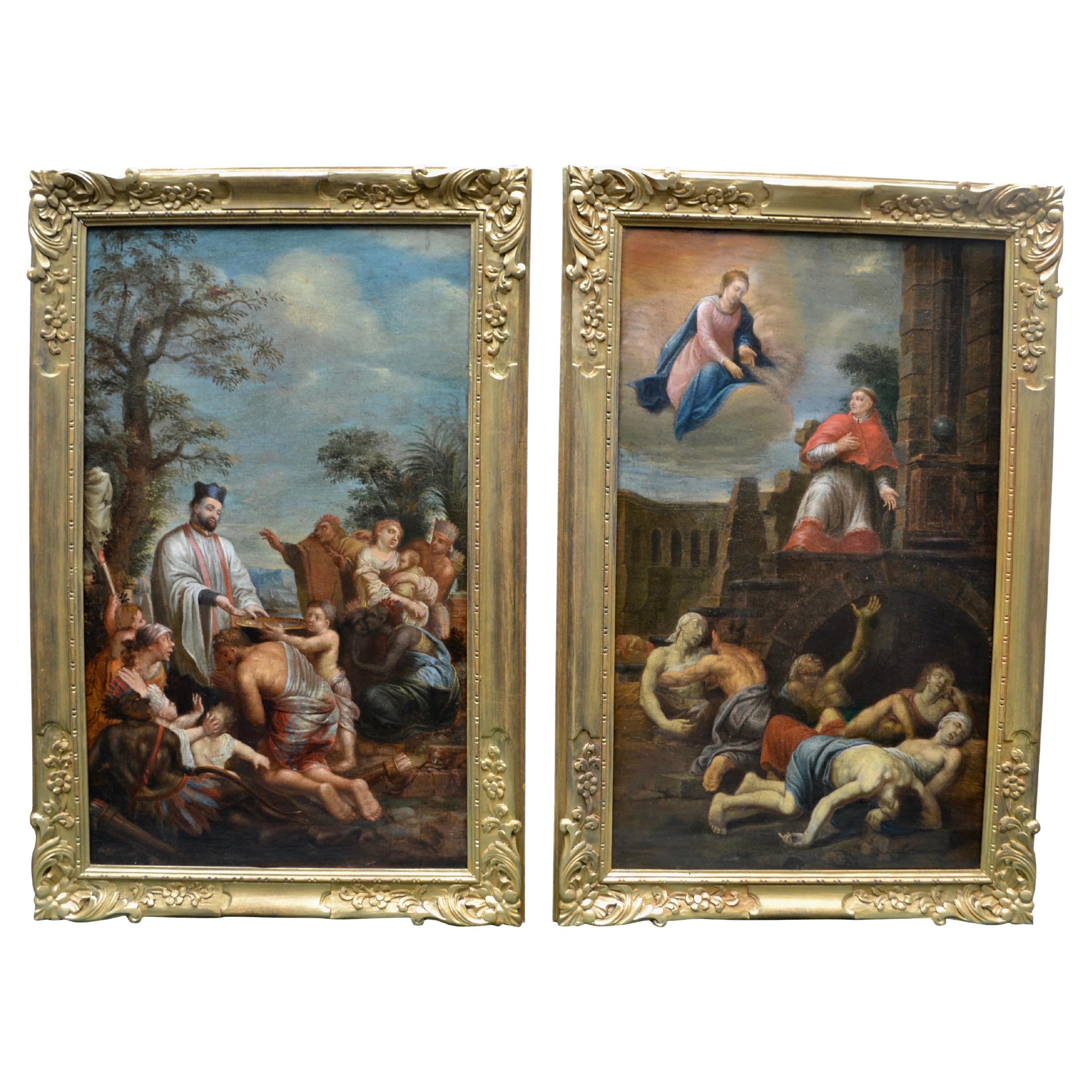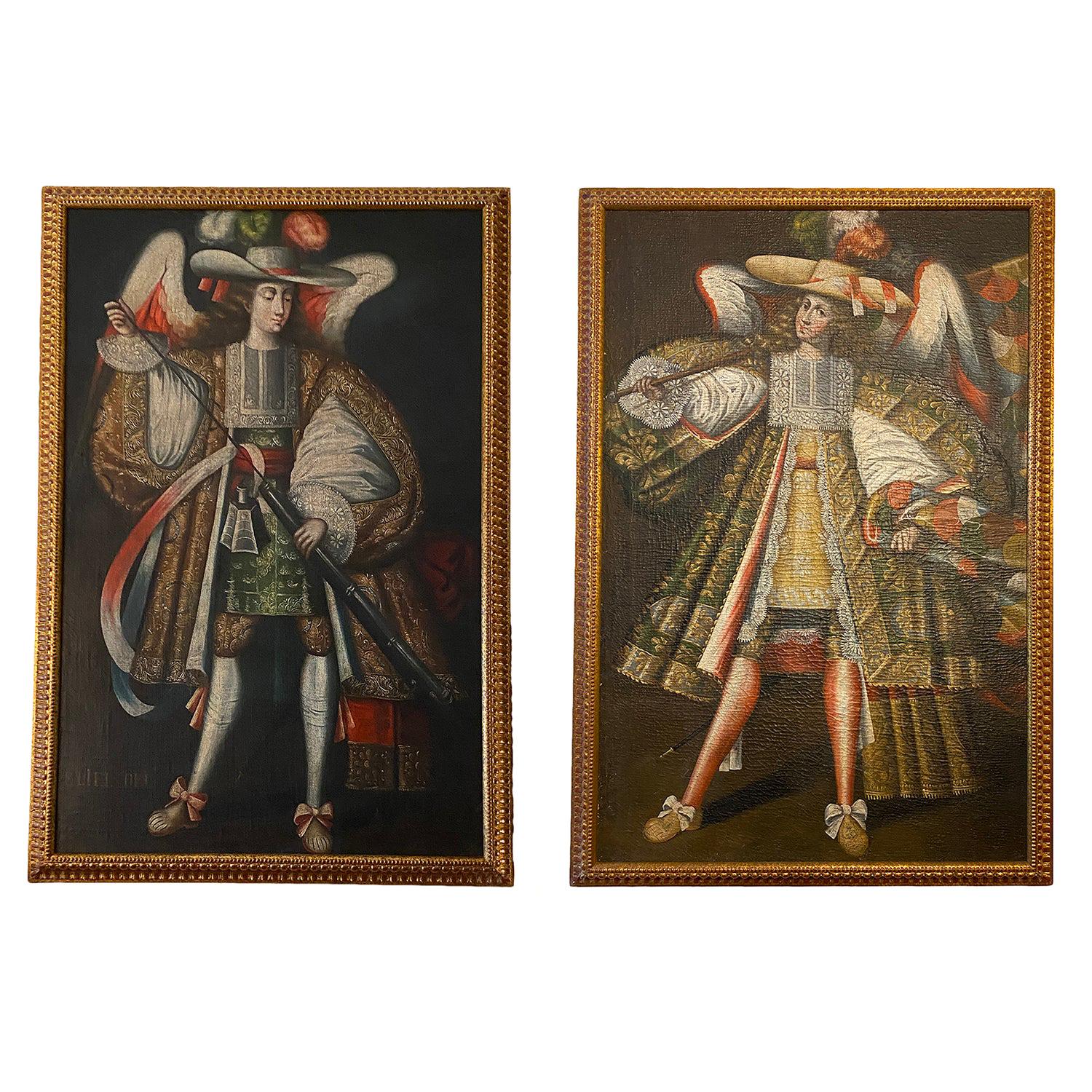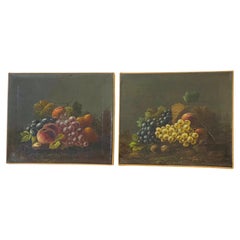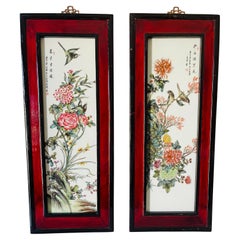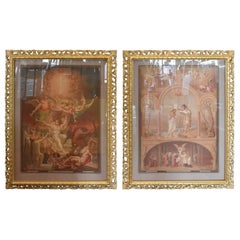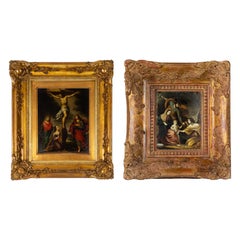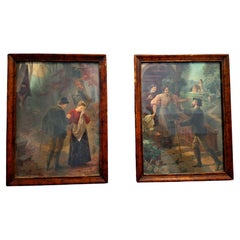Items Similar to Pair of Antique Religious Folk Art Paintings Jesus Stations
Want more images or videos?
Request additional images or videos from the seller
1 of 6
Pair of Antique Religious Folk Art Paintings Jesus Stations
$1,500per set
£1,145.24per set
€1,323.32per set
CA$2,105.72per set
A$2,347.04per set
CHF 1,231.41per set
MX$28,661.18per set
NOK 15,592.34per set
SEK 14,737.14per set
DKK 9,876.50per set
About the Item
Pair of Antque folk art religious paintings, oil on canvas, Jesus stations. Some paint loss . Will be shipped without glass and frame.
- Dimensions:Height: 30 in (76.2 cm)Width: 23 in (58.42 cm)Depth: 1 in (2.54 cm)
- Sold As:Set of 2
- Style:Folk Art (In the Style Of)
- Materials and Techniques:
- Place of Origin:
- Period:1900-1909
- Date of Manufacture:1900
- Condition:Wear consistent with age and use. Good condition.
- Seller Location:Boca Raton, FL
- Reference Number:1stDibs: LU10196245979262
About the Seller
No Reviews Yet
Vetted Professional Seller
Every seller passes strict standards for authenticity and reliability
1stDibs seller since 2024
18 sales on 1stDibs
Typical response time: 3 hours
- ShippingRetrieving quote...Shipping from: Boca Raton, FL
- Return Policy
Authenticity Guarantee
In the unlikely event there’s an issue with an item’s authenticity, contact us within 1 year for a full refund. DetailsMoney-Back Guarantee
If your item is not as described, is damaged in transit, or does not arrive, contact us within 7 days for a full refund. Details24-Hour Cancellation
You have a 24-hour grace period in which to reconsider your purchase, with no questions asked.Vetted Professional Sellers
Our world-class sellers must adhere to strict standards for service and quality, maintaining the integrity of our listings.Price-Match Guarantee
If you find that a seller listed the same item for a lower price elsewhere, we’ll match it.Trusted Global Delivery
Our best-in-class carrier network provides specialized shipping options worldwide, including custom delivery.More From This Seller
View AllAntique Icon St George Miracle Worker with Oklad
Located in Boca Raton, FL
Antique 19 th c orthodox icon tempera on gold leaf on wood in polychrome enamel embossed brass oklad. Saint George The Miracle Worker defeating the dragon. Great level of master work...
Category
Antique 1850s Russian Classical Greek Paintings
Materials
Brass
19 th c Antque Oil on Canvas Still Lives W Grapes Paintings
Located in Boca Raton, FL
Early 19 th c 1820 pair of oil on canvas still life quality paintings, European, style of Bogdani. Overall even craquellure, professionally conserved.
Category
Antique 1820s Paintings
Materials
Canvas
19 th c Orthodox Maria with Jesus Tempera on Wood Icon
Located in Boca Raton, FL
Antique 19 th c Orthodox icon Maria with baby Jesus. Tempera on wood on gold leaf ornate background. Split in wood boards due to age. restored.
Category
Antique 1890s Paintings
Materials
Wood
Pair of Chinese Porcelain Plaques Mahogany Frame
Located in Boca Raton, FL
Pair of antique Chinese Qing Dynasty porcelain polychrome plaques, pai ted with flowers and si ging birds. Signed and inscribed in Chinese upper right and left corners. Framed in red...
Category
Antique Early 1900s Chinese Chinoiserie Paintings and Screens
Materials
Porcelain
$1,550 / set
3 Antique Italian Views of Venice Drawings 1778
Located in Boca Raton, FL
3 antique 18 th c Italian ink drawings on paper of views of Venice- Dougaba and Santa Maria church, Piazza San Marco with Campanile, Venice fort. framed later. Inscribed and dated.
Category
Antique 1770s Italian Baroque Drawings
Materials
Paper
$3,500 / set
TW Stuart Pair of Blue Abstract Large Dcale Paintings
Located in Boca Raton, FL
Pair of large scale acrylic on canvas paintings by TW Stuart, 1987, Blue Absttact Dyptich.
Category
Vintage 1980s American Modern Paintings
Materials
Canvas, Acrylic
$3,850 Sale Price / set
30% Off
You May Also Like
Pair of Catechisme en Images Religious Works in Carved Wood Frames
Located in Toledo, OH
Pair of Catechisme en Images in carved wooden frames, No. 15, Je Crois a la Resurrection de la Chair and No. 19 Le Bapteme. Marked 8, Rue Francois 1 er, Paris in the lower right. Eac...
Category
Antique Late 19th Century Prints
Materials
Paper
Pair Of Baroque Paintings Of Christ, 17th Century, Italy
Located in Lisbon, PT
A pair of Italian baroque paintings of Jesus Christ:
- An 18th Century painting that depicts the Holy Family, Child Jesus, the Virgin Mary and the elderly Saint Joseph, with the An...
Category
Antique 17th Century Italian Baroque Paintings
Materials
Copper
$12,333 Sale Price / set
22% Off
Austro Hungarian Art Deco pair of Hand Panted lithography
Located in Los Angeles, CA
Pair of Austro Hungarian hand panted litografi .Wooden frame .
Category
Vintage 1930s Austrian Art Deco Paintings
Materials
Paint, Wood
Pair, 19th Century Allegorical Reverse Glass Paintings Depicting Saint Barbara
Located in Atlanta, GA
**Pair of 19th Century Allegorical Reverse Glass Paintings Depicting Saint Barbara**
This remarkable pair of **19th-century allegorical reverse glass paintings** captures the vene...
Category
Antique 19th Century Swiss Renaissance Paintings
Materials
Glass, Giltwood, Paint
$760 Sale Price / set
20% Off
Pair of 18 Century Paintings of St Francis Xavier and St Carlo Borromeo
Located in Vancouver, British Columbia
A beautifully executed and rare complementary pair of oil on canvas paintings depicting two of the moist famous and important counter reformation catholic saints St Francis Xavier and St Carlo Borromeo shown in scenes of what the respective saints are mostly famous for. St Francis Xavier for the conversion to Christianity of many S. E Asian countries notably India and St Carlo Borromeo shown asking the Virgin Mary to intercede for the cessation of the terrible plague of 1576. The paintings are presented in refreshed gilded carved wooden frames and are unsigned.
St. Francis Xavier was born in Spanish Navarre in 1506 and in 1528, he met St. Ignatius of Loyola. He became one of the seven in 1534 who founded the Society of Jesus (Jesuit Order). In 1536, he left the University of Paris and joined St. Ignatius in Venice. He was ordained in 1537, and in 1540 after the Society was recognized by the Pope, he journeyed to the Far East. Francis Xavier first evangelized the Portuguese colony of Goa in India, then Travancore, Ceylon, Malacca, and the surrounding islands. From there he journeyed to Japan, where he gave Christianity such deep roots that it survived centuries of violent persecution. He died on Sancian Island in 1552, while he was seeking to penetrate into the great forbidden land of China.
Despite language problems, lack of funds, resistance from the Europeans as well as the natives, he persevered. St. Francis converted more people in his life than anyone since the Apostle St. Paul. He baptized over 3 million people, converted the entire town of Goa in India, and he labored in India, Pakistan, Bangladesh, Sri Lanka, Malaysia, Indonesia, Singapore, and Japan. He was truly a missionary par excellence.
St Carlo Borromeo (1538-1584), was a Cardinal of the Holy Roman Catholic Church and Archbishop of Milan from 1565 to 1583. He was described in the decree for his canonization, as “a man, even while the world smiles on him with the utmost flattery, he lives crucified to the world, spiritually, trampling earthly things, seeking continuously the things of heaven, emulating the life of the Angels on earth, in his thoughts and actions.
The plague began in the month of August that year. Milan was celebrating joyfully the arrival of Don John of Austria, on his way to Flanders, where he had been appointed governor. The city authorities were abuzz with excitement in their desire to bestow the highest honours on the Spanish prince, but Charles, who had been Archbishop of the diocese for six years, was following with concern the news coming from Trento, Verona and Mantua, where the plague had begun claiming victims. The first cases exploded in Milan on August 11th, right at the moment when Don John of Austria arrived. The victor of Lepanto, followed by the governor, Antonio de Guzmán y Zuñiga, departed the city, while Carlo Borromeo, who was in Lodi for the Bishop’s funeral, returned in haste.
Confusion and fear reigned in Milan and the Archbishop dedicated himself completely to assisting the sick and ordering public and private prayers. Dom Prosper Guéranger sums up his infinite charity in this way: “In the absence of local authorities, he organized the health service, founded or renewed hospitals, sought money and provisions, decreed preventive measures. Most importantly though, he took steps to ensure spiritual help, assistance to the sick and the burial of the dead. Unafraid of being infected, he paid in person, by visiting hospitals, leading penitential processions, being everything to everyone, like a father and true shepherd”
St. Carlo was convinced that the epidemic was “a scourge sent by Heaven” as chastisement for the sins of the people and that recourse to spiritual measures was necessary to fight against it: prayer and penitence. He rebuked the civil authorities for having placed their trust in human measures rather than divine ones. “Hadn’t they prohibited all the pious gatherings and processions during the time of the Jubilee? For him, and he was convinced of it, these were the causes of the chastisement. The magistrates who governed the city continued to oppose public ceremonies, out of fear that the large gathering of people would spread contagion, but Charles “who was guided by the Divine Spirit” – recounts another biographer – convinced them by citing various examples, among which was the one regarding St. Gregory the Great who had halted the plague devastating Rome in 590.
While the pestilence spread, the Archbishop then ordered three general processions to take place in Milan on the 3rd, 5th and 6th of October, “to placate the wrath of God”. On the first day, the Saint, despite it not being the Lenten season, placed ashes on the heads of the thousands gathered, exhorting them to penitence. Once the ceremony was over, the procession went to the Basilica of St. Ambrose. Charles put himself at the head of the people, dressed in a hooded purple robe, barefoot, penitential cord at his neck and large cross in his hand.
The second procession led by the Cardinal headed towards the Basilica of San Lorenzo. The third day the procession from the Duomo headed for the Basilica of Santa Maria at San Celso. St. Carlo carried in his hands a relique of Our Lord’s Holy Nail, which had been given by the Emperor Theodosius to St. Ambrose in the 5th century.
The plague didn’t show any signs of waning and Milan appeared depopulated, as a third of its citizens had lost their lives and the others were in quarantine or didn’t dare leave their homes. The Archbishop ordered about twenty stone columns with a cross at the top to be erected in the main squares and city crossroads, allowing the inhabitants from every quarter to take part in the Masses and public prayers - from the windows of their homes. One of Milan’s protectors was St. Sebastian, the martyr the Romans had recourse to during the plague in 672. St. Charles suggested that the magistrates of Milan reconstruct the sanctuary dedicated to him, which was falling into ruins, and to celebrate a solemn feast in his honour for ten years. Finally in July 1577, the plague ceased and in September the founding stone was laid in the civic temple of St. Sebastian, where on January 20th every year, even today a Mass is offered to recall the end of the scourge.
St.Carlo Borromeo died on November 3rd 1584 and was buried in the Duomo of Milan. His heart was solemnly translated to Rome, in the Basilica of Saints Ambrose...
Category
Antique Late 18th Century French Baroque Paintings
Materials
Canvas
Pair of Spanish Colonial Archangel Paintings
Located in New York, NY
A pair of circa 1950's Spanish archangel paintings with giltwood frames.
Measurements:
Height: 58.5"
Width: 40"
Depth: 3".
Category
Vintage 1950s Peruvian Paintings
Materials
Wood
$22,000 / set
